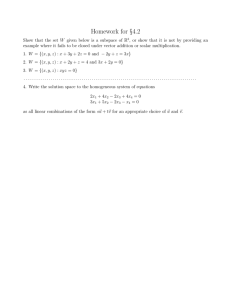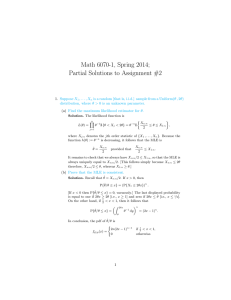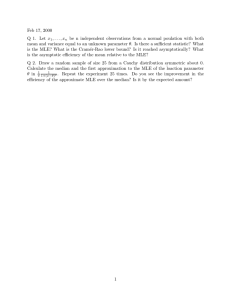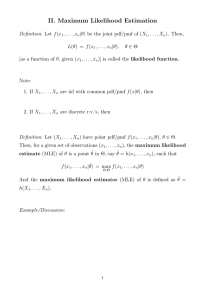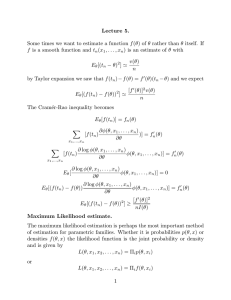Document 13434506
advertisement
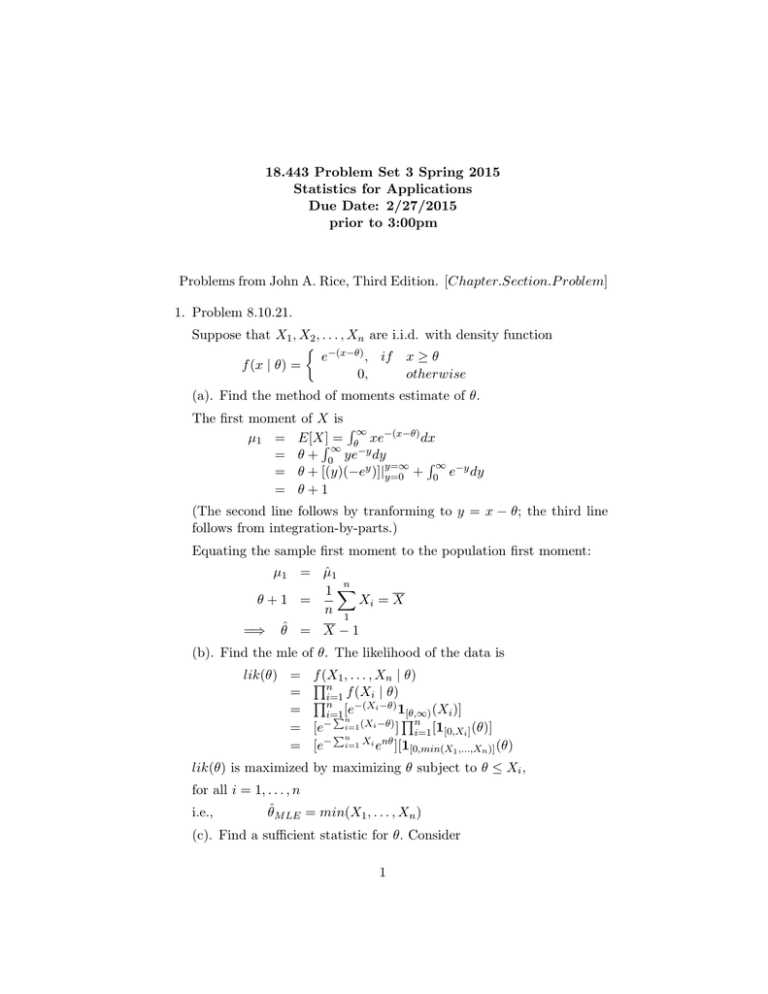
18.443 Problem Set 3 Spring 2015 Statistics for Applications Due Date: 2/27/2015 prior to 3:00pm Problems from John A. Rice, Third Edition. [Chapter.Section.P roblem] 1. Problem 8.10.21. Suppose that X1 , X2 , . . . , Xn are i.i.d. with density function f (x | θ) = e−(x−θ) , if 0, x≥θ otherwise (a). Find the method of moments estimate of θ. The first moment of X is ∞ µ1 = E[X] = θ xe−(x−θ) dx ∞ = θ + 0 ye−y dy ∞ −y = θ + [(y)(−ey )]|y=∞ y=0 + 0 e dy = θ+1 (The second line follows by tranforming to y = x − θ; the third line follows from integration-by-parts.) Equating the sample first moment to the population first moment: µ1 = µ̂1 n 1 θ+1 = Xi = X n 1 =⇒ θˆ = X − 1 (b). Find the mle of θ. The likelihood of the data is lik(θ) = ff(X1 , . . . , Xn | θ) n = f (Xi | θ) fi=1 n −(Xi −θ) 1 = [θ,∞) (Xi )] i=1 [e f n n − i=1 (Xi −θ) ] = [e i=1 [1[0,Xi ] (θ)] n = [e− i=1 Xi enθ ][1[0,min(X1 ,...,Xn )] (θ) lik(θ) is maximized by maximizing θ subject to θ ≤ Xi , for all i = 1, . . . , n i.e., θˆ M LE = min(X1 , . . . , Xn ) (c). Find a sufficient statistic for θ. Consider 1 T (X1 , . . . , Xn ) = min(X1 , . . . , Xn ) The distribution function of T , FT (t) satisfies [1 − FT (t)] = = = = = P (T > t) P 1 > t, X2 > t, . . . Xn > t) f(X n P (Xi > t) fi=1 n −(t−θ) ] i=1 [e −n(t−θ) [e ] for values t ≥ θ. The density of T is simply the derivative: fT (t | θ) = ne−n(t−θ) , t ≥ θ. The conditional density of the sample given T = t is f (X1 , . . . , Xn | θ) f (X1 , . . . , Xn | T, θ) = PfnT (t | θ) [e− i=1 Xi enθ ][1[0,min(X1 ,...,Xn )] (θ)] = [e−n(t−θ) ]1[0,t] (θ) n Pn n = [e− i=1 (Xi −t) ][ 1[t,∞) (Xi )] i=1 The density function does not depend on θ, so T = min(X1 , . . . , Xn ) is sufficient for θ. 2. Problem 8.10.45. A Random walk Model for Chromatin The html in Rproject3.zip ”Rproject3//Rproject3r mdr ayleight heory.html” details estimation theory for a sample from a Rayleigh distribution. (a). MLE of θ : Data consisting of: R1 , R2 , . . . , Rn are i.i.d. Rayleigh(θ) random variables. The likelihood function is f lik(θ) = f (r1 , . . . , rn | � θ) = �ni=1 f (ri | θ) fn � r i −ri2 � = exp i=1 θ2 2θ2 The log-likelihood function is £(θ) = log[lik(θ)] o = [ n1 log(ri )] − 2nlog(θ) − 2 1 θ2 on 2 1 [ri /2] The mle solves d dθ £(θ) = 0: d = dθ (£(θ)) o = −2n( 1θ ) + 2( θ13 ) 1n [ri2 /2] o = ( n1 n1 [ri2 /2])1/2 0 =⇒ θ̂M LE (b). Method of moments estimate: The first moment of the Rayleigh(θ) distribution is R∞ µ1 = E[R | θ] = 0 rf (r | θ)dr R∞ r r2 = 0 r θ2 exp( − )dr 2θ2 2 R ∞ r = θ12 R0 r2 exp( − )dr 2θ2 ∞ −v 1 √ ] (change of variables: v = r 2 ) = θ2 0 v · exp( 2θ2 )[ 2dv v R 3 ∞ = 2θ12 0 v 2 −1 · exp( 2−θv2 )dv 3 1 2 = √ Γ( 32 )(2θ)√ 2θ2 3 = 2θΓ( ) = 2θ × ( 21 )Γ( 21 ) √ 2 = θ × √π2 (using the facts that Γ(n + 1) = nΓ(n) and Γ( 12 ) = √ π) The MOM estimate solves: µ √1 √π 2 θ× =⇒ θˆM OM = µ̂1 = = R = R× 1 n o Ri =R √ √2 π (c). Approximate Variance of the MLE and method of moments esti­ mate. The approximate variance of the MLE is V ar(θ̂M LE ) ≈ 1 nI(θ) where I(θ) = = = = = = 2 d E[− dθ 2 (log(f (x | θ)))] 2 d2 E[− dθ2 [log( θx2 exp(− 2xθ2 ))]] 2 d E[− dθ [−2( 1θ ) − ( x2 )(−2)θ−3 ]] E[−[( θ22 ) + (x2 ))(−3)θ−4 ]] 3θ−4 E[x2 ] − ( θ22 ) = 3θ−4 (2θ2 ) − ( θ22 ) 4 θ2 3 So, V ar(θ̂M LE ) ≈ θ2 4n Variance of the MOM estimate of Rayleigh Distribution Parameter: The MOM estimate √ θˆM OM = R × √ 2 π has variance: √ V ar(θ̂M OM ) = ( √π2 )2 V ar(R) = ( π2 ) V ar(R) n 2 V ar(R) = E[R2 ] − ((E[R]) π 2 2 = 2θ − ( 2 θ) = θ2 (2 − π2 ) So, V ar(θ̂M OM ) = θ2 (2 − π2 )( π2 )( n1 ) = θ2 ( π4 − 1)( n1 ) ≈ This exceeds the approximate V ar(θ̂M LE ) ≈ θ2 n θ2 n × 0.2732 × 0.25 See the R script file: Rproject3 script4 Chromatin solution.r 3. Problem 8.10.51 Double Exponential (Laplace) Distribution The double exponential distribution is f (x | θ) = 12 e|x−θ| , −∞ < x < ∞. For an iid sample of size n = 2m + 1, show that the mle of θ is the median of the sample. Let X1 , . . . , Xn denote the sample random variables with outcomes x1 , . . . , xn . The likelihood function of the data is fn fn 1 −|xi −θ| ] lik(θ) = i | θ) = i=1 f (x i=1 [ 2 e Pn 1 n − i=1 |xi −θ| = (2) e This is maximized by minimizing the sum in the exponent: o g(θ) = ni=1 |xi − θ| Note that g(θ) is a continuous function of θ and its derivative exists at all points θ that are not equal to any xi o d g / (θ) = dθ g(θ) =o ni=1 [−1 × 1(xi > θ) + (+1) on × 1(xi < θ)] n = (−1) × [ 1(x > θ)] + (+1) × i i=1 i=1 1(xi < θ)] positive if θ > median(xi ) = negative if θ < median(xi ) 4 It follows that g(θ) is minimized at θ = median(xi ). A graph of g(θ) is piecewise linear with slope changes at each of the xi values; the slope at any given θ (not equal to an xj ) is count(xi < θ) − count(xi > θ). 4. Problem 8.10.58 Gene Frequencies of Haptoglobin Type Gene frequencies are in equilibrium, the genotypes AA, Aa, and aa oc­ cur with probabilities (1 − θ)2 , 2θ(1 − θ), and θ2 . Plato et al. published the following data on Haptoglobin Type in a sample of 190 people Haptoglobin Type Hp1-1 Hp1-2 Hp2-2 10 68 112 This is precisely the same problem as Example 8.5.1.A of the text and class notes which corresponds to count data: (X1 , X2 , X3 ) ∼ M ultinomial(n = 3, p = ((1 − θ)2 , 2θ(1 − θ), θ2 ) distribution. (a). Find the mle of θ • (X1 , X2 , X3 ) ∼ M ultinomial(n, p = ((1 − θ)2 , 2θ(1 − θ), θ2 )) • Log Likelihood for θ £(θ) = log(f (x1 , x2 , x3 | p1 (θ), p2 (θ), p3 (θ))) = log( x1 !xn!2 !x3 ! p1 (θ)x1 p2 (θ)x2 p3 (θ)x3 ) = x1 log((1 − θ)2 ) + x2 log(2θ(1 − θ)) +x3 log(θ2 ) + (non-θ terms) = (2x1 + x2 )log(1 − θ) + (2x3 + x2 )log(θ) + (non-θ terms) • First Differential of log likelihood: (2x1 + x2 ) (2x3 + x2 ) £/ (θ) = − + 1 − θ θ =⇒ θˆ = 2x3 + x2 2x3 + x2 2(112) + 68 = = = 0.76842 2n 2(190) 2x1 + 2x2 + 2x3 (b). Find the asymptotic variance of the mle. 1 E[−£// (θ)] • Second Differential of log likelihood: • V ar(θ̂) −→ 5 £// (θ) = d (2x1 + x2 ) (2x3 + x2 ) [− + ] dθ 1−θ θ (2x1 + x2 ) (2x3 + x2 ) − (1 − θ)2 θ2 • Each of the Xi are Binomial(n, pi (θ)) so E[X1 ] = np1 (θ) = n(1 − θ)2 E[X2 ] = np2 (θ) = n2θ(1 − θ) E[X3 ] = np3 (θ) = nθ2 2n • E[−£// (θ)] = θ(1 − θ) = − • σ̂θ̂2 = θ̂(1 − θ̂) 0.76842(1 − 0.76842) = = 0.0004682898 = (.02164)2 2n 2 × 190 Parts (c), (d), and (e): see the R script Rproject3 script1 multinomial simulation P roblem 8 57.r 6 MIT OpenCourseWare http://ocw.mit.edu 18.443 Statistics for Applications Spring 2015 For information about citing these materials or our Terms of Use, visit: http://ocw.mit.edu/terms.
